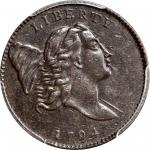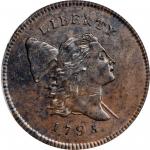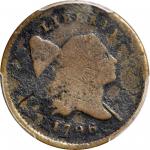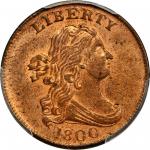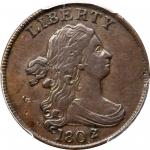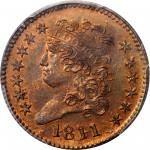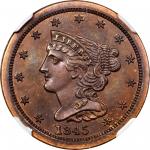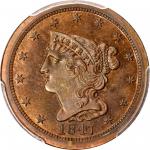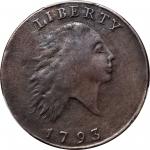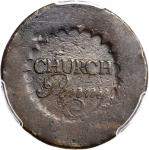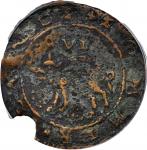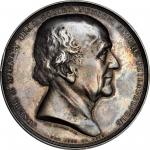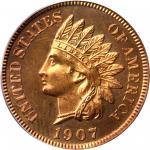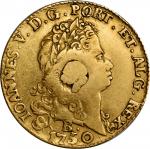(ca. 1780s) IC Regulated Brazilian 1750-B 6400 Reis ($8). Bahia Mint. 215.44 grains. Circumferentially Clipped, Plugged, Countermarked Crown IC. EF-40.30.2 mm in diameter, 1.8 mm thick at plug. We first appraised this piece in June 1980 and are now thrilled to be offering it publicly for the first time in nearly 40 years. The complexion is an even, olive-gold color with a lustrous texture visible in the protected areas. Dark traces of original patina surround the design elements, remaining most prominent on the reverse. The circumference is uniformly clipped and meticulously re-edged, while a crude plug is installed at the very center. It protrudes in an elliptical cap on the reverse and is worn flat on the obverse. A slightly domed nature is apparent on the obverse, resulting from the trauma of the regulation. The hallmark Crown IC is nicely centered on the reverse side of the plug and sits within a tightly contoured cartouche. Clearly double struck, the details of the mark are sometimes obscured by excess metal but remain largely distinct. What appears to be a diamond or a cross below the initials is likely the lower left serif of an I that was first punched too far south. The upper right serif of this I is apparent inside the upper curve of the C. An historic and apparently unique treasure from the Regulated Gold series, offering strong eye appeal and intrigue.PCGS attributes this piece to the British West Indies, which is a reasonable assumption based on the crude plug and circumferential clipping, though closer study leads us to a different region. At a current weight of 215.44 grains (8 dwt 23 grains), it is clear that this piece was regulated to the 216 grains (9 dwt) standard that was prominent throughout North America which valued this coin at $8. Though the host coin is dated 1750, the regulation probably took place once this 9 dwt standard rose to prominence in the 1770s and 1780s. At this time, however, much of the West Indies were adhering to a lower weight standard ranging from 7 to 8 dwt for a 6400 reis, indicating that our origin is likely more northward. Now looking to the North American continent, the crown in the hallmark serves as an essential clue as to where this piece might have been regulated. The crown is a relatively common hallmark that usually indicates a loyalty to the British or French throne, and the popularity of this mark among silversmiths varied considerably across regions and time periods. We find a notable similarity between the present mark and those of Boston silversmiths John Coney and Joseph Goldwaithe, which both feature crowned initials. These two were among the more prominent silversmiths of New England working in the early 18th century, and Coney is particularly famous for hosting Paul Revere’s father, Apollos Rivoire, as his apprentice. In addition, he engraved the plates for some of Massachusetts’ earliest paper currency. Despite the stylistic similarities, Coney and Goldthwaite were working earlier in the century and were likely dead at the time this piece was regulated.While we see similarities in several other Boston silversmiths, an American regulation is actually unlikely. By the late 18th century there was little support for the monarchy remaining in the Colonies, and it would have been an unwise business decision for a silversmith to use a crown hallmark in a market of Patriots. However, the crown mark was still employed by Canadian silversmiths through the end of the 18th century, as “New France” was passed seamlessly from one imperial power to the next via the Royal Proclamation of 1763 issued by King George III as a consequence for the French and Indian War. Quebec and Montreal were the largest economic centers of Canada in this era, and they maintained strong relationships with the American colonies. While the regulatory weight standards in these cities fluctuated slightly throughout the late 18th century, they ultimately conformed to the 216 grains (9 dwt) standard used in New England in order to maintain these relationships. Montreal was particularly reliant on trade with New York, as many of its merchants had emigrated from the neighboring colony and trade was made convenient by way of Lake Champlain. Quebec was a major trading partner with Massachusetts to the south, taking advantage of the growing resources that Boston offered as an international seaport. We first see the 216 grains (9 dwt) standard adopted by Canadian merchants and local governments around 1772, only to be officially recognized by the Lower Canadian Legislature in April 1795.There were many important silversmiths working in Montreal and Quebec during 1770s and 1780s, and the comparing the hallmarks of these craftsmen provide further closes at to the identity of our regulator. Most of the crown marks used throughout North America were angular, with three or more spires at the top. However, the present crown is distinctly rounded and lacks any sharp edges. A narrow and flat lobe comprises the base while two smaller conical lobes sit on top to each side. There is one central spire in the form of a rounded mound that rises up from the top of the crown, but the mark is still far from ornate. Additionally, the closely conforming cartouche is a distinctly uncommon feature and serves as an important stylistic marker. While several Canadian silversmiths employed a mark that roughly resembles this current piece, the form-fitting cartouche and rudimentary, rounded crown are most closely identified with that of Ignace-Francois Delezenne, who was among the most prolific Canadian silversmiths, perhaps only surpassed by Robert Cruickshank. Born in 1718, Ignace-Francois Delezenne was likely trained in his hometown of Lillie, France, and traveled to North America around 1740 as a skilled silversmith. He established a business in Montreal as early as 1743, and then moved to Quebec in November 1752. His latest works can be dated to around 1784, just a few years before his death in 1790. He is most significant as a pioneer of Fur Trade silver, opening up a new market beyond the table silver and church silver that dominated the metalworking trade. Delezenne’s earlier works are marked with a crowned IF and D centered below, though he changed to a crowned DZ around the time the British took power in 1763. He continued to use this mark through the rest of his career and it is found on more than half of his surviving work. While the present mark is clearly not that of Ignace-Francois himself, the stylistic similarities cannot be ignored. He had a strong following among the silversmiths of Quebec, several of whom adopted a similar style including, most notably, François Ranvoyzé. It could certainly be assumed that one of these apostles is responsible for the present regulation.An interesting candidate to consider is Delezenne’s son Joseph-Christophe Delezenne, whom apprenticed under his father beginning around 1775, until joining the American Army in 1776 and eventually settling at West Point as Captain in the 1780s. His initials provide a convenient match (the letter J is usually rendered as an I) and his less experienced hand might explain the crude repunching. However, it would be unusual for an apprentice to use a distinct mark of their own. As is the case with many coins from the Regulated gold series, close study of this piece encourages immense fascination and many questions. Though the evidence of the coin itself certainly hints at a Quebecois origin, we may never identify the regulator with absolute certainty. What we do know, with steadfast clarity, is that this piece was an essential element in the early North American economy, and it remains an incredibly rare and desirable relic of that foundational era.Appraised by Stacks in June 1980, and held since in a private collection.


